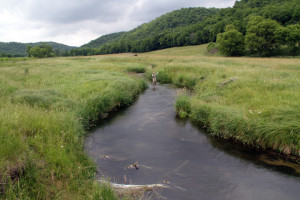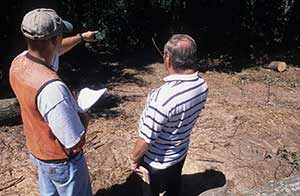Assistance: Conservation
Is assistance available for conservation practices?
Land that is well cared for not only provides many benefits to you, the landowner, but also to society. That’s why various county, state, and federal governments will share the cost with you of implementing land care and conservation practices on your property.
Don’t be confused by the different agencies. Often, these county, state, and federal providers work closely with each other (sometimes out of the same building) to provide the most complete services for you.

Read about the specific programs they offer below.
Wisconsin Forest Landowner Grant Program
The Wisconsin Department of Natural Resources’ (WDNR’s) Wisconsin Forest Landowner Grant Program (WFLGP) reimburses qualified landowners for up to 50 percent of the cost of eligible practices, such as writing a forest stewardship plan, planting trees and regenerating forest, controlling invasive species, and protecting soil and water quality.
To be eligible, landowners must own between 10 and 500 continuous acres of non-industrial, private forestland within Wisconsin. In addition, practices for which you seek reimbursement must be identified in a forest stewardship or Managed Forest Law plan, except if you’re applying to WFLGP to develop a plan in the first place.
Public access to your land is not required under this cost-share program; however, you are expected to contact your WDNR forester for guidance prior to submitting an application. You’ll also need to get written approval from the DNR before starting a practice or you’ll be ineligible for funding.
Environmental Quality Incentives Program

Managed by the USDA-Natural Resources Conservation Service (NRCS), the Environmental Quality Incentives Program (EQIP) helps owners of farmland and non-industrial forestland voluntarily plan and carry out practices that improve water quality, reduce soil erosion, create wildlife habitat, and meet other conservation goals.
In the case of woodlands, these practices generally include planting trees, improving forest stands, and preparing sites for natural forest regeneration.
EQIP uses a ranking process for applications designed to direct funds to projects that offer the greatest benefits. The program will also share the cost of developing a specific type of forest stewardship plan, known as a Conservation Activity Plan (CAP).
For a woods to qualify for EQIP, it must be large enough to be managed as a production unit (a five-acre woodlot, for example, is typically not big enough), and participants are subject to the Adjusted Gross Income limits of the Farm Bill. EQIP contracts run for one to 10 years, and landowners may be eligible for flat-rate payments based on the average costs of practices. Public access to land is not required.
For more details, contact your local NRCS agent today!
Conservation Reserve Program
Administered by the USDA-Farm Service Agency, the Conservation Reserve Program (CRP) encourages landowners to convert their poor cropland into rich conservation land. In exchange for returning farmland to wetland, prairie, or woods, landowners receive annual rental payments from the federal government to offset any loss of income.

A voluntary program, CRP focuses on planting erosion-prone farmland to trees, grasses, and other perennial species that will improve environmental health and quality.
In addition to providing rental payments, the program will share the costs of implementing revegetation and restoration practices.
Your land’s eligibility for CRP depends on its soil types and cropping history, and it must also be suitable for specific conservation measures, such as filter strips, wetland restoration, and riparian buffers.
CRP contracts run for 10 to 15 years and can be transferred to a new owner. Public access to enrolled land is not required.
Conservation Stewardship Program
The Conservation Stewardship Program (CSP), administered by NRCS, helps producers and landowners maintain and improve their existing conservation systems, as well as to adopt additional practices to address priority resource concerns. Participants earn payments based on conservation performance: the higher the performance, the higher the payment.
Eligible lands include cropland, grassland, pastureland, rangeland, and nonindustrial, private forestland, and all producers are eligible, regardless of operation size. Applicants must meet the stewardship threshold for at least two priority resource concerns when they apply. They must also agree to meet or exceed the stewardship threshold for at least one additional priority resource concern by the end of the contract.
Public access to enrolled lands is not required by this program.
